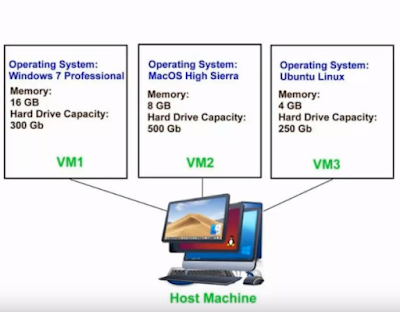Different Types of Client
Thin Client:
It is nothing but from the browser we are browsing the sites.
Thick Client:
It is nothing but, which we browser through apps, are nothing but Thick Client.
The basic difference between both terms is that the thin client uses a remote computer for processing an application. Whereas, the thick client does the application processing by itself as it locally runs the applications.
What is Server
A server is a computer program or device that provides a service to another computer program and its user, also known as the client
Different Types of Servers
1. Web server
An open-source web server is used for accessing the world wide web through public domain software.
2. Proxy server
Proxy servers act as a bridge between a host server and a client server. A proxy sends data from a website to your computer IP address after it passes through the proxy's server.
3. Virtual machine (VM)
As their name suggests, virtual machines store and connect data strictly through virtual space. To create a virtual machine, IT teams use a hypervisor, also known as a virtual machine monitor (VMM), which is software that can run thousands of virtual machines through only one piece of physical hardware
Mail server
A mail server stores and delivers mail for clients through email service platforms.
Print server
A print server connects remotely to local computers to print through a network.
Application Server
These servers connect clients to software applications through virtual server connections.
What is On Premise ?
Scenario
Assume that, I am having an application, which will tell me the number of seats available in the bus.
As soon as the person selects the seats he makes payment than we need to update saying that ticket is booked.
Now, assume that they are 20 people daily access the your application, and in the next weak again 50 + people are accessing the application . Daily the network traffic is increasing. So more number of people are using than CPU wont support.
CPU (Server): The above image is CPU Server.
Now, daily the people are going on increasing, so your CPU cannot handle it because of less configuration.(RAM & Memory)
To over come, either we need to go with
- Bigger Configuration
- Buy Bigger configuration and transfer your data into the new CPU(Server)
- Rent a server
Below image shows how the physical server looks
Now, we need to connect server to Switches and Switches to Router.
Now below, is the image of how this Server are kept inside the Rack
Now, again more number of people are increasing than more number of servers and more number of Racks. Below is the image
The above image is how the data center looks.
In real term how it works is
1 --> Firewall which will check if the request is valid or Not
2--> Router
3 -> Switch
4,5,6--> Server(Which will be kept inside Racks)
We will have load balancer, based on that it will check which is having less load and it will redirect to that server.
Drawbacks of Physical Server
I want to deploy the two application with different versions.
nginx 2.4
nginx 2.6
This is not possible, as we cannot installed both the versions in the single server.
Then they came up with a solution called as Virtual Machines.
What is VM(Virtual Machine)
Now, we can also create multiple VMS based on the Physical Server.
A device which is created by a piece of software is called as virtualization.
Inside each VM, we can installed different types that is in
one vm i can have application server
second vm i can have database server
third vm i can have mail server.
A virtual machine (VM) is a virtual environment that functions as a virtual computer system with its own CPU, memory, network interface, and storage, created on a physical hardware system
Software called a hypervisor separates the machine's resources from the hardware and provisions them appropriately so they can be used by the VM.
Based on the software Hypervisor , I can create my own Operating System and other things.
Oracle Virtual box, VM Ware virtual Box.
Based on the hardware capabilities we can create no of VMS.
Drawback: Assume that if the physical server is crashed, then in that case we cannot access the Virtual Machines.

















No comments:
Post a Comment
Thank you for visiting my blog